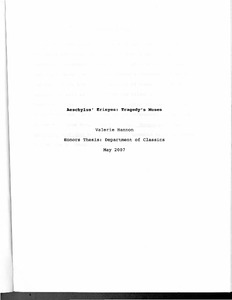| dc.rights.license | In Copyright | en_US |
| dc.creator | Hannon, Valerie Octavia Ho'olehua | |
| dc.date.accessioned | 2023-10-20T18:01:44Z | |
| dc.date.available | 2023-10-20T18:01:44Z | |
| dc.date.created | 2007 | |
| dc.identifier | WLURG038_Hannon_thesis_2007 | |
| dc.identifier.uri | https://dspace.wlu.edu/handle/11021/36544 | |
| dc.description.abstract | The over-arching theme of Aeschylus' trilogy, the Oresteia, is the emergence of law from vengeance, but does the author also address the nature of tragedy through an innovative treatment of song and the Erinyes? Peter Wilson and Oliver Taplin thought so: "The Eumenides supplies a kind of 'aetiology' of tragedy -- that is, of itself."[1]
Beginning with Wilson and Taplin's intriguing idea, this paper will explore the evolving nature, function, and representation of the Erinyes before, during, and after the Oresteia was first performed, in order to determine how Aeschylus granted them a clearly defined identity, transforming these goddesses from the fearful shadows of epic into tragedy's Muses. [From Introduction] | en_US |
| dc.format.extent | 78 pages | en_US |
| dc.language.iso | en_US | en_US |
| dc.rights | This material is made available for use in research, teaching, and private study, pursuant to U.S. Copyright law. The user assumes full responsibility for any use of the materials, including but not limited to, infringement of copyright and publication rights of reproduced materials. Any materials used should be fully credited with the source. | en_US |
| dc.rights.uri | http://rightsstatements.org/vocab/InC/1.0/ | en_US |
| dc.subject.other | Washington and Lee University -- Honors in Classics | en_US |
| dc.title | Aeschylus' Erinyes: Tragedy's Muses | en_US |
| dc.type | Text | en_US |
| dcterms.isPartOf | WLURG038 - Student Papers | en_US |
| dc.rights.holder | Hannon, Valerie Octavia Ho'olehua | en_US |
| dc.subject.fast | Oresteia (Aeschylus) | en_US |
| dc.subject.fast | Criticism and interpretation | en_US |
| dc.subject.fast | Erinyes (Greek mythology) | en_US |
| local.department | Classics | en_US |
